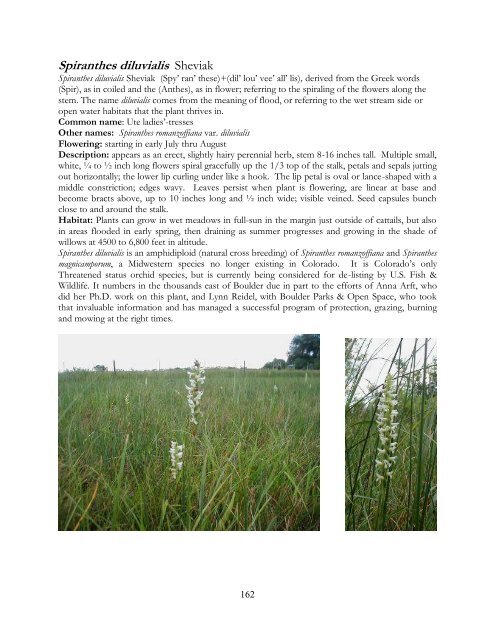Scotty Smith's Orchids of Colorado. - Southwest Colorado Wildflowers
Scotty Smith's Orchids of Colorado. - Southwest Colorado Wildflowers
Scotty Smith's Orchids of Colorado. - Southwest Colorado Wildflowers
You also want an ePaper? Increase the reach of your titles
YUMPU automatically turns print PDFs into web optimized ePapers that Google loves.
Spiranthes diluvialis SheviakSpiranthes diluvialis Sheviak (Spy‟ ran‟ these)+(dil‟ lou‟ vee‟ all‟ lis), derived from the Greek words(Spir), as in coiled and the (Anthes), as in flower; referring to the spiraling <strong>of</strong> the flowers along thestem. The name diluvialis comes from the meaning <strong>of</strong> flood, or referring to the wet stream side oropen water habitats that the plant thrives in.Common name: Ute ladies‟-tressesOther names: Spiranthes romanz<strong>of</strong>fiana var. diluvialisFlowering: starting in early July thru AugustDescription: appears as an erect, slightly hairy perennial herb, stem 8-16 inches tall. Multiple small,white, ¼ to ½ inch long flowers spiral gracefully up the 1/3 top <strong>of</strong> the stalk, petals and sepals juttingout horizontally; the lower lip curling under like a hook. The lip petal is oval or lance-shaped with amiddle constriction; edges wavy. Leaves persist when plant is flowering, are linear at base andbecome bracts above, up to 10 inches long and ½ inch wide; visible veined. Seed capsules bunchclose to and around the stalk.Habitat: Plants can grow in wet meadows in full-sun in the margin just outside <strong>of</strong> cattails, but alsoin areas flooded in early spring, then draining as summer progresses and growing in the shade <strong>of</strong>willows at 4500 to 6,800 feet in altitude.Spiranthes diluvialis is an amphidiploid (natural cross breeding) <strong>of</strong> Spiranthes romanz<strong>of</strong>fiana and Spiranthesmagnicamporum, a Midwestern species no longer existing in <strong>Colorado</strong>. It is <strong>Colorado</strong>‟s onlyThreatened status orchid species, but is currently being considered for de-listing by U.S. Fish &Wildlife. It numbers in the thousands east <strong>of</strong> Boulder due in part to the efforts <strong>of</strong> Anna Arft, whodid her Ph.D. work on this plant, and Lynn Reidel, with Boulder Parks & Open Space, who tookthat invaluable information and has managed a successful program <strong>of</strong> protection, grazing, burningand mowing at the right times.162







